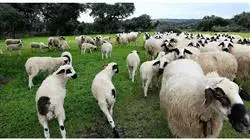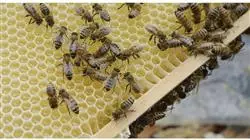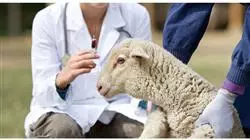University certificate
The world's largest faculty of veterinary medicine”
Description
We offer you the most comprehensive training in the market to bring Extensive Livestock Management to the same level as clinical and sanitary practice, offering your clients the highest quality in both services"

The Professional master’s degree in Extensive Livestock Management has a comprehensive program that covers the widest spectrum of species and breeds used in Animal Production Not only are the most common productions, such as those derived from cattle, sheep, goats, pigs and classic poultry farming, given in-depth and specialized attention, but also other much less common but highly relevant productions are incorporated, such as beekeeping or hunting productions, which demand a greater degree of specialization from professionals in the area.
Likewise, the level of knowledge and professional experience of the course professors allows them to address very specific productions, such as those related to fighting cattle, where it is very difficult to access levels of specialization, except for the small number of people who have had the opportunity to develop their knowledge within the scope of this type of livestock farming.
Equine production, which is usually neglected in other programs of this type, is also in great demand for specialized professionals at the highest level, especially in the production of animals for sports disciplines, which are in high demand and have a very high market value.
The high levels of knowledge provided by the faculty in the areas of economics, genetics and animal breeding contribute decisively to consolidate and expand knowledge in two areas that are absolutely fundamental to achieve success in the management of extensive livestock production.
Immerse yourself in this high quality educational training, which will enable you to meet the future challenges of Extensive Livestock Management "
This Professional master’s degree in Extensive Livestock Management contains the most complete and up-to-date scientific program on the market. The most important features of the program include:
- The development of case studies presented by experts in the management of veterinary centers
- The graphic, schematic, and practical contents with which they are created, provide scientific and practical information on the disciplines that are essential for professional practice
- New developments in Extensive Livestock Management
- Practical exercises where self-assessment can be used to improve learning
- Special emphasis on innovative methodologies in Extensive Livestock Management
- Theoretical lessons, questions to the expert, debate forums on controversial topics, and individual reflection assignments
- Content that is accessible from any fixed or portable device with an Internet connection
In this Professional master’s degree you will study in depth the knowledge of the main cattle breeds exploited in extensive beef production"
It includes, in its teaching staff, professionals belonging to the field of Extensive Livestock Management , who bring to this training the experience of their work, in addition to recognized specialists from prestigious leading societies and universities.
Its Multimedia Content, elaborated with the latest Educational Technology, will allow the Professional a situated and contextual learning, that is to say, a Simulated Environment that will provide an immersive specialization programmed to train in real situations.
This program is designed around Problem Based Learning, whereby the specialist must try to solve the different professional practice situations that arise during the academic year. To do so, the professional will be assisted by an innovative interactive video system created by recognized experts in Extensive Livestock Management .
This training comes with the best didactic material, providing you with a contextual approach that will facilitate your learning"

This 100% online Advanced Master's Degree will allow you to combine your studies with your professional work while increasing your knowledge in this field"
Syllabus
The structure of the contents has been designed by the best professionals in the Extensive Livestock Management sector, with extensive experience and recognized prestige in the profession, backed by the volume of cases reviewed and studied, and with a broad command of new technologies.

We have the most complete and up-to-date academic program in the market. We strive for excellence and for you to achieve it too"
Module 1. Genetic Resources of Extensive Populations and Programs for Improvement and Promotion of the Different Breeds
1.1. Relevance of Biodiversity in the Sustainable Development of the Planet
1.1.1. Biodiversity Concept
1.1.2. Importance of Biodiversity Conservation
1.1.3. Threats to the Maintenance of Biodiversity
1.2. Measurement of Genetic Diversity
1.2.1. Genetic Diversity
1.2.2. Consequences of the Loss of Genetic Diversity: Inbreeding
1.2.3. Molecular Tools for Measuring Diversity
1.2.4. Measures of Genetic Diversity
1.2.5. Genetics and Extinction
1.3. Animal Genetic Resources: Current Situation
1.3.1. Concept of Animal Genetic Resources
1.3.2. Distribution of Animal Genetic Resources at the Global Level
1.3.3. Distribution of Animal Genetic Resources by Domestic Species
1.3.4. Current Trends in Gene Flows
1.4. Methods of Conservation of Animal Genetic Resources
1.4.1. Inventory of Animal Genetic Resources
1.4.2. Conservation in situ
1.4.3. Conservation ex situ
1.5. Contribution of Native Breeds and the Extensive Farming System to the Maintenance of Biodiversity
1.5.1. Livestock and Landscape
1.5.2. Adaptation of Populations to the Environment
1.5.3. Conservation of Extensive Ecosystems
1.5.4. Livestock Utilization and Fire Prevention
1.6. Population Conservation Programs: Endangered Breeds
1.6.1. Justification for the Existence of Population Conservation Programs Socioeconomic Implications. Sustainable Development
1.6.2. Population Conservation Objectives
1.6.3. Stock Conservation Criteria
1.6.4. Methodology Used in the Conservation of Stocks
1.6.5. Forecast of Genetic Resources to be Utilized and Future Population Trends
1.7. Stock Enhancement Programs: Beef Cattle
1.7.1. Selection Objectives
1.7.2. Selection Criteria
1.7.3. Individual Identification and Parentage Control
1.7.4. Yield Control
1.7.5. Genetic Evaluations
1.7.6. Testing of Player Candidates
1.7.7. Dissemination of the Improvement
1.8. Population Improvement Programs: Small Ruminants
1.8.1. Selection Objectives
1.8.2. Selection Criteria
1.8.3. Individual Identification and Parentage Control
1.8.4. Yield Control
1.8.5. Genetic Evaluations
1.8.6. Testing of Player Candidates
1.8.7. Dissemination of the Improvement
1.9. Stock Improvement Programs: Extensive Pig Farming
1.9.1. Selection Objectives
1.9.2. Selection Criteria
1.9.3. Individual Identification and Parentage Control
1.9.4. Yield Control
1.9.5. Genetic Evaluations
1.9.6. Testing of Player Candidates
1.9.7. Dissemination of the Improvement
1.10. Population Conservation Programs: Other Species
1.10.1. Conservation Programs for Game Species
1.10.2. Conservation Programs for Other Species of Ecological Interest
Module 2. Lidia Cattle Production
2.1. Prototypes and Breed Base of the Fighting Cattle I
2.1.1. Origins of the Fighting Bull
2.1.2. The Bravery of the Bull and its Manifestations
2.1.3. Coats and Horns of the Fighting Cattle
2.1.4. Foundational Castes
2.1.5. Breeds derived from the Vistahermosa I Caste
2.2. Prototypes and Breed Base of the Fighting Cattle II
2.2.1. Breeds derived from the Vistahermosa II Breed
2.2.2. Crossbreeding with the Casta de Vistahermosa Breed
2.2.3. The Lidia Breed in Portugal
2.2.4. The Fighting Breed in France
2.2.5. The Lidia Breed in Mexico
2.2.6. The Lidia Breed in Colombia
2.2.7. The Lidia Breed in Ecuador
2.2.8. The Lidia Breed in Venezuela
2.2.9. The Peruvian Lidia Breed
2.3. Herd Book of the Lidia Cattle Breed
2.3.1. Historical Precedents
2.4. Selection in the Fighting Breed
2.4.1. General Aspects of Selection in the Lidia Breed
2.4.2. Morphological Selection
2.4.3. Genealogical Selection
2.4.4. Functional and Behavioral Selection. The Temptation and its Results
2.4.5. Other Selection Methods
2.4.6. Selection Pressure
2.4.7. Proof of Offspring
2.4.8. Pardon as a Method of Selection
2.4.9. The Breeding Program for the Lidia Breed
2.5. Breeding and Production Cycles of the Fighting Cattle
2.5.1. Coverage
2.5.2. Birth and Lactation
2.5.3. The Unborn and Weaning
2.5.4. The Horseshoe Mill
2.5.5. Rearing
2.5.6. The Selection of Breeders
2.5.7. Handling, Stowage and Shipments
2.5.8. Recognition in the Bullring
2.6. The Feeding of Fighting Cattle
2.6.1. General Dietary Guidelines
2.6.2. The Feeding of Breeding Cows
2.6.3. Stallion Feeding
2.6.4. Heifer Feeding
2.6.5. Yearling Feeding
2.6.6. Feeding of Erales (Young Bulls)
2.6.7. Feeding of Foals
2.6.8. Feeding of Bulls
2.7. Most Frequent Pathologies in Lidia Cattle
2.7.1. Infectious Pathologies
2.7.2. Parasitic Pathologies
2.7.3. Nutrition-Related Pathologies
2.7.4. Pathologies Related to the Breeding and Management of Fighting Cattle
2.7.5. Injuries Produced During Bullfighting and their Treatment in Pardoned Bulls
2.8. Management and Facilities for Fighting Cattle Breeding
2.8.1. Handling Facilities in Lidia Cattle Farming
2.8.2. Management of Breeding Cows
2.8.3. Stallion Management
2.8.4. Management of Rebreeding Heifers
2.8.5. Management of Males from Yearlings to Bulls
2.8.6. Halters, Dogs and Other Elements Used in the Handling of Fighting Bulls
2.9. Assisted Reproduction in Fighting Livestock
2.9.1. Peculiarities of Assisted Reproduction in the Cattle of the Fighting Bulls
2.9.2. Techniques for Semen Collection and Preservation
2.9.3. Artificial Insemination
2.9.4. Techniques for Oocyte Retrieval and Preservation
2.9.5. Embryo Procurement, Conservation and Transfer Techniques
2.9.6. The Market for Genetics in the Cattle Breeding Industry
2.10. Economics of the Cattle Breeding Farm
2.10.1. The Current Bullfighting Bull Market
2.10.2. Income and Expenses of Lidia Cattle Farming
2.10.3. Production Costs
2.10.4. Income from Sales and Subsidies
2.10.5. Rural Tourism as a Complementary Income
2.10.6. The Profitability of the Farms in the Bullfighting Industry
2.10.7. Current Situation and Economic Prospects of the Lidia Cattle Breeding Industry
Module 3. Extensive Beef Cattle Production
3.1. Racial Basis of Extensive Beef Cattle Production I
3.1.1. Beef Cattle Morphology
3.1.2. Production and Adaptation to the Environment
3.1.3. Indigenous Breeds Specialized in Meat Production
3.1.4. Endangered Native Breeds Specialized in Meat Production
3.2. Racial Basis of Extensive Beef Cattle Production II
3.2.1. Mixed Breeds Specialized in Meat Production
3.2.2. Main European, American and Asian Breeds Specialized in Meat Production
3.2.3. Cebuinos and Hybrids
3.2.4. Buffalo
3.2.5. Bisontes
3.3. Yield Control and Data Collection Systems
3.3.1. Individual Morphological, Productive and Reproductive Data (Study Variables)
3.3.2. External and Internal Influencing Factors
3.3.3. Methodologies for Data Collection and Analysis
3.4. Extensive Beef Cattle Production Systems and Handling Facilities
3.4.1. Grazing in Beef Cattle
3.4.2. The Pasture
3.4.3. Grazing in Mountain Areas
3.4.4. Grazing in Other Rainfed Areas
3.4.5. Grazing on Irrigated Farms and in Marsh Areas
3.4.6. Dietary Supplementation in Extensive Beef Cattle Production Systems
3.4.7. Rearing and Handling Facilities for Beef Cattle Farmed in Extensive Systems
3.5. Beef Cattle Feeding in Extensive Farming
3.5.1. General Feeding Guidelines for Cattle in Extensive Production
3.5.2. Cow Feeding in Different Ecosystems
3.5.3. Stallion Feeding
3.5.4. Feeding of Replacement Heifers
3.5.5. Feeding of Beef Calves in Extensive Systems
3.6. Most Frequent Pathologies in Beef Cattle Farmed in Extensive Systems
3.6.1. Pathologies of Infectious Origin
3.6.2. Pathologies of Parasitic Origin
3.6.3. Pathologies of Metabolic Origin
3.6.4. Reproductive Pathologies
3.6.5. Pathologies Related to Handling
3.7. Reproductive Management of Beef Cattle Farms
3.7.1. Reproductive Systems Used in Extensively Farmed Beef Cattle
3.7.2. Reproductive Management of Cows
3.7.3. Reproductive Management of Stallions
3.7.4. Reproductive Management of Heifers
3.8. Organoleptic Characteristics and Meat Quality in Beef Produced in Extensive Systems. Beef Production for PGI and PDO. Organic Production
3.8.1. Organoleptic Characteristics and Meat Quality of Beef from Cattle Produced in Extensive Systems
3.8.2. Protected Geographical Indications in Beef Cattle
3.8.3. Beef Cattle Protected Denominations of Origin
3.8.4. Organic Beef Cattle Production
3.9. Production of Beef and Other Red Meat in Extensive Systems. Wagyu Beef Production. Lidia Meat. Buffalo Meat Bison Meat
3.9.1. Beef Production in Extensive Beef Systems
3.9.2. Beef Production in Extensive Systems
3.9.3. Wagyu and Kobe Beef Production
3.9.4. Lidia Beef
3.9.5. Buffalo Meat
3.9.6. Bison Meat
3.10. Economic Aspects of Beef Cattle Production in Extensive Systems
3.10.1. Income and Expenses of Extensive Beef Cattle Farms
3.10.2. Main Factors Affecting Farm Profitability
3.10.3. The Extensive Beef Cattle Market
3.10.4. Current Situation and Future Prospects
Module 4. Extensive Sheep Meat and Milk Production
4.1. Meat Production II
4.1.1. Health
4.1.2. Feeding
4.1.3. Installations
4.1.4. Types of Commercial Meat and their Labeling
4.2. Dairy Sheep Production
4.2.1. Reproduction Characteristics and Systems. Reproductive Planning. Crosses
4.2.2. Feeding, Facilities, Handling
4.2.3. Milk Characteristics, Cheese Yields
4.3. Sheep Production
4.3.1. Wool Morphology
4.3.2. Production Worldwide
4.3.3. Evolution of Production and Profitability
4.4. Future of Sheep Production
4.4.1. Influence of the Common Agricultural Policy
4.4.2. Culinary Culture
4.4.3. Labor Factor
4.4.4. Production Costs
4.4.5. Importance in the Social Structure of the Rural World
Module 5. Extensive Goat Meat and Dairy Production
5.1. Breed Base I: Dairy Goats
5.1.1. Foreign Breeds
5.2. Breed Base II: Meat Goats, Dual Purpose and Other Aptitudes
5.2.1. Foreign Breeds
5.3. Goat Breeding and Management
5.3.1. General Management of Beef Goats
5.3.2. General Management of Dairy Goats
5.4. Goat Feeding and Nutrition
5.4.1. Dairy Goat Feeding
5.4.2. Beef Goat Feeding and Other Abilities
5.5. Livestock Health Management
5.5.1. Disease Prevention: Health Plan
5.5.2. Most Common Pathologies
5.5.3. Most Frequent Injuries Derived from the Type of Exploitation
5.6. Goat Facilities
5.6.1. Minimum Facilities for Goats for Meat Production
5.6.2. Minimum Facilities in Dairy Goats
5.6.3. Animal Welfare
5.7. Reproductive Management of Goats
5.7.1. Characteristics of the Sexual Cycle and Gestation
5.7.2. Individual Reproductive Parameters
5.7.3. Reproductive Management: Estrus Induction and Synchronization of Estrus
5.7.4. Reproductive Plan Farms
5.8. Main Products Related to Goat Milk
5.8.1. Milk and Cheese
5.8.2. Other Dairy Products
5.8.3. PDO and PGI Products
5.9. Main Products Related to Goat Meat
5.9.1. Suckling Kid
5.9.2. Goats, Goat and Other Meat By-Products
5.9.3. PDO and PGI Products
5.10. Other Goat Production Capabilities
5.10.1. Hair and Fiber
5.10.2. Leather and Hides
5.10.3. Manure
5.10.4. Other Uses
5.10.5. By-Products
Module 6. Iberian Swine and Other Extensive Swine Production
6.1. Introduction and Situation of the Sector
6.1.1. Global Situation
6.1.2. Situation Europe
6.2. Racial Basis
6.2.1. Pure Breeds
6.2.2. Commercial Hybrids
6.3. Extensive Swine Production System
6.3.1. Other Countries
6.4. Type of Farms
6.4.1. Iberian Pork
6.4.2. Non-Iberian Pork
6.5. Breeders and Breeding Techniques
6.5.1. Female Selection
6.5.2. Covering of Females
6.5.3. Gestation of Females
6.5.4. Childbirth
6.5.5. Selection and Final Destination of Males
6.6. Production Cycle
6.6.1. Nursing
6.6.2. Dairy
6.6.3. Bait
6.6.4. Finishing
6.7. Handling, Animal Welfare and Facilities
6.7.1. Extensive Swine Management
6.7.2. Animal Welfare in Extensive Swine Farms
6.7.3. Pig Management Facilities for Extensive Swine Production
6.8. Nutrition and Phased Program
6.8.1. General Aspects of Swine Nutrition
6.8.2. Feeding of Breeding Sows and Boars
6.8.3. Piglet Feeding
6.8.4. Feeding in the Fattening Phase
6.8.5. Feeding in the Finishing Phase
6.9. Health and Most Common Pathologies
6.9.1. Health in Extensive Swine Farms
6.9.2. Infectious Pathologies
6.9.3. Parasitic Pathologies
6.9.4. Pathologies Related to Nutrition
6.9.5. Pathologies Derived from Handling
6.9.6. Reproductive Pathologies
6.9.7. Other Pathologies
Module 7. Extensive Production. Hunting and Equine
7.1. Types of Game Farms I
7.1.1. Deer
7.1.2. Swine
7.1.3. Rabbit and Hare
7.2. Types of Game Farms II
7.2.1. Red-Legged Partridge
7.2.2. Quail
7.2.3. The Influence of the World Economy on the Hunting Sector
7.3. The Importance and Evolution of the Horse Industry
7.3.1. Establish the Transition from Animal Traction to Mechanical Traction
7.3.2. Equestrian Culture, Analysis
7.3.3. Production Evolution
7.4. Establishment of the Various Equestrian Disciplines
7.4.1. Sports
7.4.2. Leisure
7.4.3. Entertainment
Module 8. Classic and Alternative Poultry Farming
8.1. Extensive Poultry Breeding
8.1.1. Breeding
8.1.1.1. Eggs
8.1.1.2. Meat
8.1.1.2.1. Chicken
8.1.1.2.2. Neutered
8.1.1.2.3. Poulards
8.1.1.2.4. Partridges
8.1.1.2.5. Quails
8.1.1.2.6. Ducks and Geese
8.1.1.2.7. Pheasant
8.1.1.2.8. Ostrich
8.1.1.3. Other Breeds
8.1.2. Quality of Your Products
8.1.2.1. Certifications
8.1.2.2. Quality Seal
8.1.3. Traceability and Labeling
8.2. Birds
8.2.1. Origin of Birds
8.2.1.1. Native
8.2.1.2. Commercial Hybrids
8.2.2. Physiological Characteristics
8.2.2.1. Reproduction
8.2.3. Behaviour
8.3. Installations
8.3.1. Regulations
8.3.2. Accommodation
8.3.2.1. Comederos
8.3.2.2. Drinking Fountains
8.3.2.3. Nesting Boxes or Bird Nests
8.3.2.4. Lighting
8.3.3. Parks
8.3.4. Litter or Bed
8.4. Management
8.4.1. Hens
8.4.1.1. Grazing
8.4.1.2. Lay Down
8.4.1.3. Broodiness
8.4.1.4. Beak Cutting
8.4.1.5. Nesting Boxes or Bird Nests
8.4.1.6. Poulards
8.4.1.7. Pecking
8.4.2. Chicken
8.4.2.1. Fattening
8.4.2.2. Neutered
8.4.3. Periwinkle
8.4.4. Quail
8.4.5. Geese and Ducks
8.4.6. Pheasant
8.4.7. Ostrich
8.5. Feeding
8.5.1. Nutritional Requirements
8.5.2. Nutrition Management
8.5.3. Water
8.6. Health Program and Veterinary Treatments
8.6.1. Bird Control
8.6.2. Vaccines
8.6.3. Deworming
8.6.4. Official Controls
8.6.4.1. Influenza Aviar
8.6.4.2. Salmonella
8.7. Most Common Pathologies
8.7.1. Most Common Diseases
8.7.1.1. Viral
8.7.1.2. Bacterial
8.7.1.3. Internal Parasites
8.7.1.4 .External Parasites
8.7.1.5. Mycotic
8.7.2. Notifiable Diseases
8.8. Animal Welfare
8.8.1. Objectives
8.8.1.1. Correct Feeding
8.8.1.2. Correct Lodging
8.8.1.3. Good Health
8.8.1.4. Correct Behavior
8.9. Biosecurity
8.9.1. Farms
8.9.1.1. Location and Registration
8.9.1.2. Installations
8.9.1.3. Material
8.9.1.4. Accessible
8.9.1.5. Handling System
8.9.2. Animals
8.9.2.1. Chicks
8.9.2.2. Domestic Animals
8.9.2.3. Wild Animals
8.9.2.4. Health Program
8.9.3. Feed and Drinking Water
8.9.3.1. Feed
8.9.3.2. Water
8.9.4. Personnel, Facilities and Sanitary Standards
8.9.4.1. Farm Personnel
8.9.4.2. Sanitary Facilities and Standards
8.9.5. Material
8.9.5.1. Equipment
8.9.6. Biocides and Phytosanitary Products
8.9.7. Waste Disposal
8.9.8. Cleaning and Disinfection Protocol
8.9.9. Records and Documentation
8.10. Organic Poultry Farming
8.10.1. Breeding
8.10.2. Installations
8.10.3. Feeding
8.10.4. Health
Module 9. Beekeeping
9.1. The Bee
9.1.1. Bee Morphology
9.1.2. Anatomy and Physiology
9.1.3. Evolutionary Stages
9.1.4. The Castes
9.2. The Queen Bee
9.2.1. Queen Cells, Birth of the Queen
9.2.2. Life in the Hive and Work of the Queen
9.2.3. Mating
9.2.4. Egg Laying and Development
9.2.5. Some Problems Associated with the Queen
9.3. The Workers
9.3.1. Birth of the Workers
9.3.2. Worker Development and First Foraging
9.3.3. Worker Ethology
9.3.4. Pollination
9.3.5. Melliferous Flora
9.4. Drones
9.4.1. Drone Morphology and Anatomy
9.4.2. Function of Drones
9.4.3. Bee Species and Breeds
9.4.4. The Bee Colony
9.5. Flowers
9.5.1. Nectar
9.5.2. Pollen
9.5.3. Propolis or Bee Glue
9.5.4. Myelate
9.6. Beekeeping Equipment
9.6.1. Beehives
9.6.2. Operating Tools
9.6.3. Material Used in the Collection
9.6.4. Material Used in Queen Rearing
9.6.5. Maintenance and Disinfection of Equipment
9.7. Hostile Elements for the Hive. Main Bee Diseases
9.7.1. Main Enemies of Bees
9.7.2. Bee Diseases
9.7.3. Treatment of Pathologies
9.7.4. Sanitary Defense
9.8. Installation and Control of the Apiary. Winter Jobs
9.8.1. Location of Hives
9.8.2. Winter Surveillance
9.8.3. First Inspection after Winter
9.8.4. Post-Winter Beehive Preparation
9.9. Work in the Hive during the Year
9.9.1. Address of the Apiary
9.9.2. Spring Jobs
9.9.3. Summer Jobs
9.9.4. Autumn Jobs
9.10. Products Derived from Beekeeping and How to Obtain Them
9.10.1. Honey
9.10.2. Pollen
9.10.3. Wax
9.10.4. Poisons
9.10.5. Propolis
Module 10. Economic Aspects Related to Extensive Livestock Farming
10.1. Economics of Extensive Livestock Farming
10.1.1 The Breeding Factors; their Relationship and Importance; the SAFFE
10.1.1.1. Introduction
10.1.1.2. The Basis of SAFEE
10.1.1.3. SAFEE Objectives
10.1.1.4. Initial Conclusions
10.1.1.5. Second Conclusions
10.1.1.6. Third Conclusions
10.1.1.7. Fourth Conclusions
10.2. The Basis of Your Business Finances
10.2.1. Introduction
10.2.2. Accounting and its Types
10.2.3. Control and Development of Accounting Models
10.2.4. The Main Accounting Principles
10.2.5. Finance
10.2.6. Treasury
10.2.7. The Balance Sheet
10.3. Income Statement and Economic Flows
10.3.1. Introduction
10.3.2. Results Research
10.3.3. Economic and Financial Cash Flows
10.3.4. The Added Value
10.3.5. Initial Conclusions
10.4. Equity and Financial Analysis of Livestock Production
10.4.1. Introduction
10.4.2. Operation of the Financial Accounts
10.4.3. Equity Accounts
10.4.4. Difference Accounts
10.4.5. Profit and Loss Accounts
10.4.6. Checks
10.4.7. Arrangement of the Balance Sheet
10.4.8. Analysis of the Development of the Balance Sheet
10.4.9. Initial Conclusions
10.5. The Main Ratios to be Considered in Extensive Livestock Farming I
10.5.1. Introduction
10.5.2. The Relative Value of Ratios
10.5.3. Types of Ratios
10.5.4. Ratios to Evaluate Profitability
10.5.5. Ratios to Evaluate Liquidity
10.5.6. Debt Diagnosis Ratios
10.6. The Main Ratios to be Considered in Extensive Livestock Farming II
10.6.1. Introduction
10.6.2. Ratios for Diagnosing Asset Turnover
10.6.3. Collection Management Ratios
10.6.4. Payment Management Ratios
10.6.5. Other Ratios of Interest
10.6.6. Initial Conclusions
10.7. Bases of Livestock Economic Analysis
10.7.1. Introduction
10.7.2. Percentage Valuation
10.7.3. Analysis of Commercial Actions
10.7.4. Analysis of Expenses
10.7.5. Productivity Analysis
10.7.6. Analysis of Efficacy
10.7.7. Initial Conclusions
10.8. The Problem of Financing Extensive Livestock Farming
10.8.1. Introduction
10.8.2. Interest from Financing Sources
10.8.3. The Debt Policy and its Costs
10.8.4. The Structure of Indebtedness
10.8.5. Sources of Indebtedness
10.8.6. Self-financing
10.8.7. Initial Conclusions
10.9. Economic Planning in Extensive Livestock Farming I
10.9.1. The budget
10.9.2. The Cash Budget
10.9.3. Budget Execution
10.9.4. The Flexible Budget
10.10. Economic Planning in Extensive Livestock Farming II
10.10.1. Analysis of Budget Deviations
10.10.2. The Interim Income Statement
10.10.3. Provisional Balance Sheet
10.10.4. Conclusions

This training will allow you to advance in your career comfortably"
Professional Master's Degree in Extensive Livestock Management
.
The Professional Master's Degree in Extensive Livestock Management of TECH Global University has been designed by the best specialists in the field, thanks to this you will have the possibility to access high quality content. In addition, throughout our program we will boost your skills by means of an innovative audiovisual system, which will help you to internalize easily and quickly the different thematic axes provided in each lesson. Our goal with this innovative postgraduate course of 1,500 instructive hours is to form an optimal conceptual background, through which you will be able to address topics such as species production, conservation programs for endangered livestock populations and the correct economic management of the sector.
Study a postgraduate degree in extensive livestock management
.
In this program of the Faculty of Veterinary Medicine of TECH you will find an updated curriculum, with which you will develop specialized knowledge in different areas, among which stand out the management of populations at risk, biodiversity, extensive productions and classical poultry farming, among other thematic approaches that will be of utmost importance for your professional praxis. Upon successful completion of our program, you will have access to a professional degree of international prestige and recognition.







